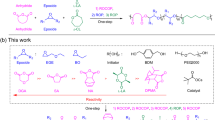Abstract
The chain-growth polymerization mechanism is essentially unsuitable for sequence control due to the statistical propagation feature. However, the development of reversible-deactivation radical polymerization (RDRP) has opened the door to sequence control for carbon–carbon bond-based synthetic polymers carrying various pendant groups on their repeating units. Our group has developed some methodologies and concepts for the synthesis of sequence-controlled oligomers/polymers via radical polymerization. It is crucial to introduce some additional components into the initiator and/or the monomer for RDRP, and in most cases, these components are designed to be removed or transformable afterward. This review focuses on the methodologies we have recently developed for sequence regulation via radical polymerization processes and the sequence-oriented properties of the resultant sequence-controlled polymers.
This is a preview of subscription content, access via your institution
Access options
Subscribe to this journal
Receive 12 print issues and online access
$259.00 per year
only $21.58 per issue
Buy this article
- Purchase on Springer Link
- Instant access to full article PDF
Prices may be subject to local taxes which are calculated during checkout








Similar content being viewed by others
References
Alberts B, Johnson A, Lewis JM, Roberts RK, Walter P. Molecular biology of the cell. 4th ed. New York: Garland Science; 2002.
Moad G, Solomon DH. The chemistry in radical polymerization. 2nd ed. Oxford, UK: Elsevier; 2006.
Lutz JF, Ouchi M, Liu DR, Sawamoto M. Sequence-controlled polymers. Science. 2013;341:1238149.
Ouchi M, Sawamoto M. Sequence-controlled polymers via reversible-deactivation radical polymerization. Polym J. 2018;50:83–94.
Klumperman B. Mechanistic considerations on styrene–maleic anhydride copolymerization reactions. Polym Chem. 2010;1:558–62.
Jenkins AD, Jones RG, Moad G. Terminology for reversible-deactivation radical polymerization previously called “controlled” radical or “living” radical polymerization (IUPAC Recommendations 2010). Pure Appl Chem. 2010;82:483–91.
Wang JS, Matyjaszewski K. Controlled living radical polymerization. Atom-transfer radical polymerization in the presence of transition-metal complexes. J Am Chem Soc. 1995;117:5614–5.
Kato M, Kamigaito M, Sawamoto M, Higashimura T. Polymerization of Methyl-methacrylate with the carbon-Tetrachloride dichlorotris(triphenylphosphine)ruthenium(II) methylaluminum bis(2,6-Di-Tert-butylphenoxide) initiating system: possibility of living radical polymerization. Macromolecules. 1995;28:1721–3.
Minisci F. Free-radical additions to olefins in the presence of redox systems. Acc Chem Res. 1975;8:165–71.
Pintauer T, Matyjaszewski K. Atom transfer radical addition and polymerization reactions catalyzed by ppm amounts of copper complexes. Chem Soc Rev. 2008;37:1087–97.
Satoh K, Ozawa S, Mizutani M, Nagai K, Kamigaito M. Sequence-regulated vinyl copolymers by metal-catalysed step-growth radical polymerization. Nat Commun. 2010;1:6.
Vandenbergh J, Reekmans G, Adriaensens P, Junkers T. Synthesis of sequence-defined acrylate oligomers via photo-induced copper-mediated radical monomer insertions. Chem Sci. 2015;6:5753–61.
Lutz JF, Lehn JM, Meijer EW, Matyjaszewski K. From precision polymers to complex materials and systems. Nat Rev Mater. 2016;1:14.
Ouchi M, Terashima T, Sawamoto M. Transition metal-catalyzed living radical polymerization: toward perfection in catalysis and precision polymer synthesis. Chem Rev. 2009;109:4963–5050.
Ida S, Terashima T, Ouchi M, Sawamoto M. Selective radical addition with a designed heterobifunctional halide: a primary study toward sequence-controlled polymerization upon template effect. J Am Chem Soc. 2009;131:10808–9.
Ida S, Ouchi M, Sawamoto M. Template-assisted selective radical addition toward sequence-regulated polymerization: lariat capture of target monomer by template initiator. J Am Chem Soc. 2010;132:14748–50.
Hibi Y, Ouchi M, Sawamoto M. A strategy for sequence control in vinyl polymers via iterative controlled radical cyclization. Nat Communs. 2016;7:11604.
Oh DY, Ouchi M, Nakanishi T, Ono H, Sawamoto M. Iterative radical addition with a special monomer carrying bulky and convertible pendant: a new concept toward controlling the sequence for vinyl polymers. ACS Macro Lett. 2016;5:745–9.
Oh D, Sawamoto M, Ouchi M. Precise control of single unit monomer radical addition with a bulky tertiary methacrylate monomer toward sequence-defined oligo- or poly(methacrylate)s via the iterative process. Polym Chem. 2019;10:1998–2003.
Malay AD, Arakawa K, Numata K. Analysis of repetitive amino acid motifs reveals the essential features of spider dragline silk proteins. PLoS ONE. 2017;12:e0183397.
Tsuchiya K, Kurokawa N, Gimenez-Dejoz J, Gudeangadi PG, Masunaga H, Numata K. Periodic introduction of aromatic units in polypeptides via chemoenzymatic polymerization to yield specific secondary structures with high thermal stability. Polym J. 2019;51:1287–98.
Nishimori K, Ouchi M. AB-alternating copolymers via chain-growth polymerization: synthesis, characterization, self-assembly, and functions. Chem Commun. 2020;56:3473–83.
Pasini D, Takeuchi D. Cyclopolymerizations: synthetic tools for the precision synthesis of macromolecular architectures. Chem Rev. 2018;118:8983–9057.
Hibi Y, Tokuoka S, Terashima T, Ouchi M, Sawamoto M. Design of AB divinyl “template monomers” toward alternating sequence control in metal-catalyzed living radical polymerization. Polym Chem. 2011;2:341–7.
Ouchi M, Nakano M, Nakanishi T, Sawamoto M. Alternating sequence control for carboxylic acid and hydroxy pendant groups by controlled radical cyclopolymerization of a divinyl monomer carrying a cleavable spacer. Angew Chem Int Ed. 2016;55:14584–9.
Kametani Y, Sawamoto M, Ouchi M. Control of the alternating sequence for N-isopropylacrylamide (NIPAM) and methacrylic acid units in a copolymer by cyclopolymerization and transformation of the cyclopendant group. Angew Chem Int Ed. 2018;57:10905–9.
Kametani Y, Tournilhac F, Sawamoto M, Ouchi M. Unprecedented sequence control and sequence-driven properties in a series of AB-alternating copolymers consisting solely of acrylamide units. Angew Chem Int Ed. 2020;59:5193–201.
Oh D, Furuya Y, Ouchi M. Unusual radical copolymerization of suprabulky methacrylate with N-hydroxysuccinmide acrylate: facile syntheses of alternating-rich copolymers of methacrylic acid and N-alkyl acrylamide. Macromolecules. 2019;52:8577–86.
Colquhoun H, Lutz JF. Information-containing macromolecules. Nat Chem. 2014;6:455–6.
Lutz JF. Coding macromolecules: inputting information in polymers using monomer-based alphabets. Macromolecules. 2015;48:4759–67.
Roy RK, Meszynska A, Laure C, Charles L, Verchin C, Lutz JF. Design and synthesis of digitally encoded polymers that can be decoded and erased. Nat Commun. 2015;6:7237.
Gunay US, Petit BE, Karamessini D, Al OA, Amalian JA, Chendo C, et al. Chemoselective synthesis of uniform sequence-coded polyurethanes and their use as molecular tags. Chem. 2016;1:114–26.
Konig NF, Al Ouahabi A, Oswald L, Szweda R, Charles L, Lutz JF. Photo-editable macromolecular information. Nat Commun. 2019;10:3774.
Boukis AC, Reiter K, Frölich M, Hofheinz D, Meier MAR. Multicomponent reactions provide key molecules for secret communication. Nat Commun. 2018;9:1439.
Martens S, Landuyt A, Espeel P, Devreese B, Dawyndt P, Du Prez F. Multifunctional sequence-defined macromolecules for chemical data storage. Nat Commun. 2018;9:4451.
Huang Z, Shi Q, Guo J, Meng F, Zhang Y, Lu Y, et al. Binary tree-inspired digital dendrimer. Nat Commun. 2019;10:1918.
Author information
Authors and Affiliations
Corresponding author
Ethics declarations
Conflict of interest
The author declares that he has no conflict of interest.
Additional information
Publisher’s note Springer Nature remains neutral with regard to jurisdictional claims in published maps and institutional affiliations.
Rights and permissions
About this article
Cite this article
Ouchi, M. Construction methodologies and sequence-oriented properties of sequence-controlled oligomers/polymers generated via radical polymerization. Polym J 53, 239–248 (2021). https://doi.org/10.1038/s41428-020-00405-7
Received:
Revised:
Accepted:
Published:
Issue Date:
DOI: https://doi.org/10.1038/s41428-020-00405-7



